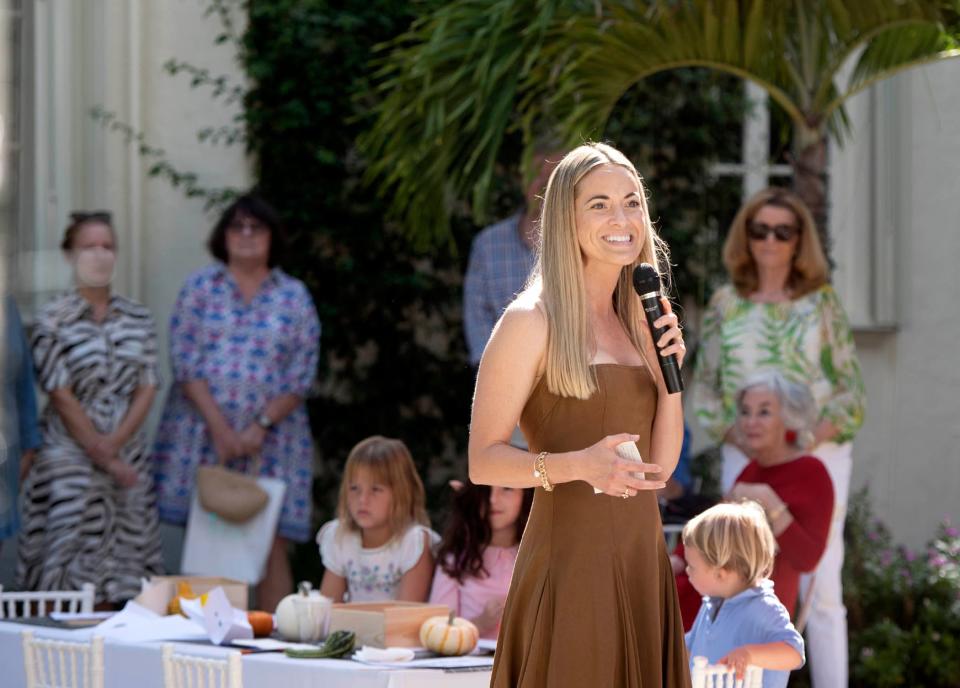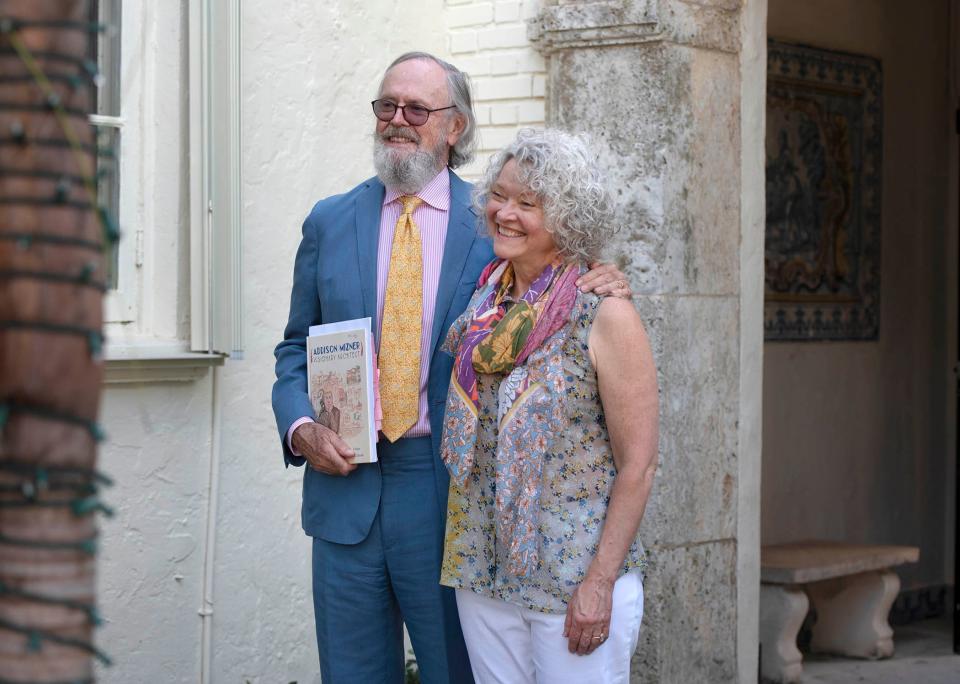Preservation Foundation of Palm Beach debuts children's book about architect Mizner
The fanciful imagination of one of the island's most influential architects is now immortalized as a children's book.
Addison Mizner, the quirky, colorful personality credited with bringing Mediterranean Revival-style architecture to Palm Beach, is the star of the new chapter book "Addison Mizner, Visionary Architect," by Robert L. Forbes, illustrated by Barbara McClintock, and published by the Preservation Foundation of Palm Beach.
More: Preservation Foundation of Palm Beach honors designer, historic Mizner building
The middle-grades book, written for ages 8 to 12 and available for $30 at www.shoppalmbeachpreservation.org, is the culmination of a longtime goal for Amanda Skier, Preservation Foundation president and chief executive.
"What's great about this book is that it has a unique marrying of primary sources from our archives and other archives around the country that have items related to Addison Mizner, and these children's illustrations," she said, noting that even though the book is written for children in fourth through sixth grades, the illustrations allow younger children to follow along.
The book's release earlier this fall was paired with the opening of the exhibition "Addison Mizner: Letters and Manuscripts," open 10 a.m. to 4 p.m. Monday to Friday through Feb. 2 at the Preservation Foundation, 311 Peruvian Ave.
The foundation marked Mizner's 100th birthday in December 2022, and has been celebrating for the year since.
"We certainly had that in mind with the release of this children's book and with the exhibition to kind of celebrate his influence on the town," Skier said.
From concept to creation
For years, the Preservation Foundation has offered its Heritage Education program, teaching local students about Palm Beach's history through its architecture. There was one component of that program that always seemed to capture the children's attention: A unit on Mediterranean Revival style.
"I think it's because Mizner was such a colorful character, and in many ways, childlike," Skier said, noting the architect's penchant for quirky pets and costume parties. "I mean, when you look at his buildings, there's never a moment for your eye to really rest. There's so much to take in."

More: Palm Beach mayor proclaims December 'Addison Mizner Month' at Worth Avenue event
She noted that students who take walking tours of Worth Avenue marvel over the resting place of Mizner's pet monkey, Johnnie Brown, which has a headstone in Via Mizner.
"They love that," Skier said. "They're just so fascinated that his monkey is buried there."
Mizner's work includes the stately Everglades Club on Worth Avenue. He also designed the asymmetrical El Solano mansion on South Ocean Boulevard, which was Mizner's home before he sold it to Harold Vanderbilt. El Solano later was home to John Lennon and Yoko Ono.
Forbes was connected with the Preservation Foundation by former board chair Pauline Pitt, who is a longtime friend of his. Forbes, a Palm Beach resident, has written several whimsical children's books including "Beastly Feasts! A Mischievous Menagerie in Rhyme." Writing for children marked a career change for Forbes, who for decades worked in the C-suite for the family business: Forbes Media, which owns Forbes magazine, among other publications and enterprises.

Writing a non-fiction children's book was "quite different" for Forbes, who said he was fascinated by Mizner as he combed through primary sources and research and created multiple drafts of the book.
"I dug out as many different articles as I could," Forbes said.
He tapped into collections both at the Preservation Foundation and the Society of the Four Arts, which has some of Mizner's albums.
"The hardest thing of course is what you leave out, because you have to edit down and keep it in way that is going to move to the arc of the story forward, and yet be intriguing chapter by chapter for the fourth-grade audience that you're writing for," he said. "You want to draw them in and make it fun for them."
With his extensive experience writing for children, Forbes was able to draw out the bits of Mizner's life that would most appeal to that age group:
Mizner's childhood trip to Central America, where his father was a minister and Mizner first discovered Mediterranean architecture.
The year he spent as a child in bed after his leg was broken during a Fourth of July celebration, where Mizner learned how to paint and developed his love of reading.
His many odd jobs, including a hotel in Hawaii where, when Mizner arrived, the man who hired him mysteriously disappeared.
His meeting socialite Paris Singer, the person who would introduce Mizner to Palm Beach.
"And that changed the architecture of South Florida forever," Forbes said.
As he did the research, Forbes thought about ways to bring the story to life. He decided to ask his friend, the illustrator McClintock, to add her touch to the book.
"And it's one of those things I've learned in life, you have to ask, and you'd be surprised what people will say," Forbes said. "She agreed to do the illustrations for it, which absolutely lifted it into a much different kind of book that I think works very nicely."
Forbes said he loved getting to know Mizner and telling "the great American story" of his life.
He quoted Frank Lloyd Wright: "Many architects had imagination, but only Addison Mizner had the courage to let it out of the cage."
Skier said the final book surpassed her expectations.
"Bob really turned the book into something that I never could have imagined in my wildest dreams," Skier said. "He is so accomplished as a children's book author that it's far surpassed the very humble goal that I had to publish a children's book for the foundation.
"We're incredibly fortunate that he agreed to take this on, and he would never tell you, but he completely did it pro bono and really took us under his wing," she added.
'Letters and Manuscipts'
The book's release coincides with the foundation's exhibition of a collection of letters and manuscripts that belonged to and were written by Mizner, from his life in Alaska to his career in Palm Beach.
Marie Penny, the former director of archives for the Preservation Foundation, worked closely with Forbes on the manuscript for the book and helped to connect him with the materials he needed to complete his research. About the same time, she was working to acquire the large collection of Mizner's works now on display.
The works were held for decades by Madena Galloway Nelrich, who was Mizner's personal assistant. "She was his right-hand woman," Penny said. "She did everything, all of his estate management and took care of his entire estate after he passed away."
Nelrich's nephew, William Bardell, donated the collection to the foundation. Included are diaries, letters, scrapbooks — even rare books that belonged to Mizner.
Penny reached out to the family after reading "Boca Rococo" by Caroline Seebohm, a book about Mizner's work in South Florida. In the introduction to "Boca Rococo," Seebohm credited the family's archives for much of her research.
"That got me thinking: That book was published almost 20 years ago. Is that stuff still in their home?" Penny said. She reached out through Seebohm, who she said was instrumental in making the connection that led to the groundbreaking donation to the foundation.
The exhibition at the Preservation Foundation is "a small selection" of the overall collection, due in part of the fragile nature of some of the documents, Penny said. "There are some beautiful watercolors that Mizner did when he was in Alaska, which I think are just incredible," she said. "They are illustrating part of a letter that he wrote to his mother."
The watercolors show Mizner and his brother pulling sleds, Penny said, noting that the paintings have a "cartoon-like quality."
"They're just incredible to see," she said.
Many of the items on display document Mizner's participation in the gold rush in Alaska at the time, she said. The exhibition also includes some of McClintock's sketches for the book, and work commissioned by the foundation from a young illustrator, Eva Williams, who interpreted some of the moments of Mizner's life, Penny said.
"They encompass the narrative of these bits and pieces of the Mizner story," she said.
If you go
What: "Addison Mizner: Letters and Manuscripts" exhibition
Where: Preservation Foundation of Palm Beach, 311 Peruvian Ave., Palm Beach
When: 10 a.m. to 4 p.m. Monday to Friday through Feb. 2
Cost: Free
Information: www.palmbeachpreservation.org
This article originally appeared on Palm Beach Daily News: 'Addison Mizner, Visionary Architect' book debuts in Palm Beach

